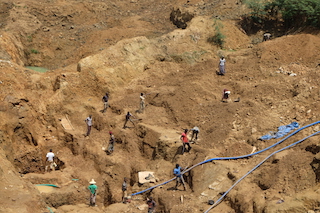The Mercury-free Gold mining technology
that I wrote about yesterday, and its links with fairtrade certification
continued in the visits that we made today. Yesterday we visited SAMA – an
alliance of small-scale miners in the Sinyonja area, and the ones who look
after the ‘Wonder Machine’ or Gold Kacha.
Today we visited two of the three other
mining cooperatives that also use the Kacha, and who are also working towards
Fairtrade Gold certification. Once all the groups have the certification, then
the plans are that they will work together to accumulate enough gold to fulfill
the minimum requirements of the international fairtrade buyers, and in so doing
be able to access the fairtrade payments faster than if they worked
independently of each other.
Chatting to Stephen, one of the miners
today, he asked me to remind people back home how important fairtrade is to the
producers and their communities. Not only do the producers get a fair price,
but working conditions are much better as they have had to fulfill a range of
health and safety measures, there is gender equality with regard to employment
and pay, there is no child labour, and through working as part of a
cooperative, the miners don’t feel isolated but can support each other in a
range of pastoral ways.
But fairtrade also recognizes that the
producers can’t work in isolation, but need a community around them to provide
various services, and so another financial gain that comes from being fairtrade
is the Community Premium. This is a payment that the producer cooperative gets given,
the size of which is linked to the amount of gold being sold, and which has to
be used to bring benefit to the community. So it might be used for improving
access to clean water, or educational facilities, or any number of other
aspects of community infrastructure. A real blessing to the whole community.
This Community Premium is a payment that is
made to the producer community no matter what the fairtrade item. So whether it
is fairtrade bananas, or tea, or cotton, or sugar, or wine…….each time a fairtrade
item is bought, the community will benefit – what a great incentive for each of
us to up our purchasing of fairtrade items.
One other mention that Stephen asked me to
make, and that is to the donors Comic Relief and Guernsey Overseas Aid
Commission, who between them provided the funds to not just purchase the Gold
Kacha etc, but also to ensure that the mining communities are sensitized,
trained and equipped regarding the wider range of fairtrade policies and
procedures, and to provide ongoing support as the communities develop and
instigate their procedures, all through Ugandan NGO EWAD.
So, a big shout out to both those donor
organisations – for all the life-changing differences they are making, and to
everyone who supports Comic Relief day etc and puts money in the pot in the
first place.
 |
| Children in the community who will benefit from the Community Premium: photo by Annie Sanderson |
 |
| One of the open mines - a hive of activity: photo by Annie Sanderson |
 |
| Our team, plus some of the miners, and an EWAD staff member - donors, facilitators and beneficiaries! photo by Annie Sanderson |



